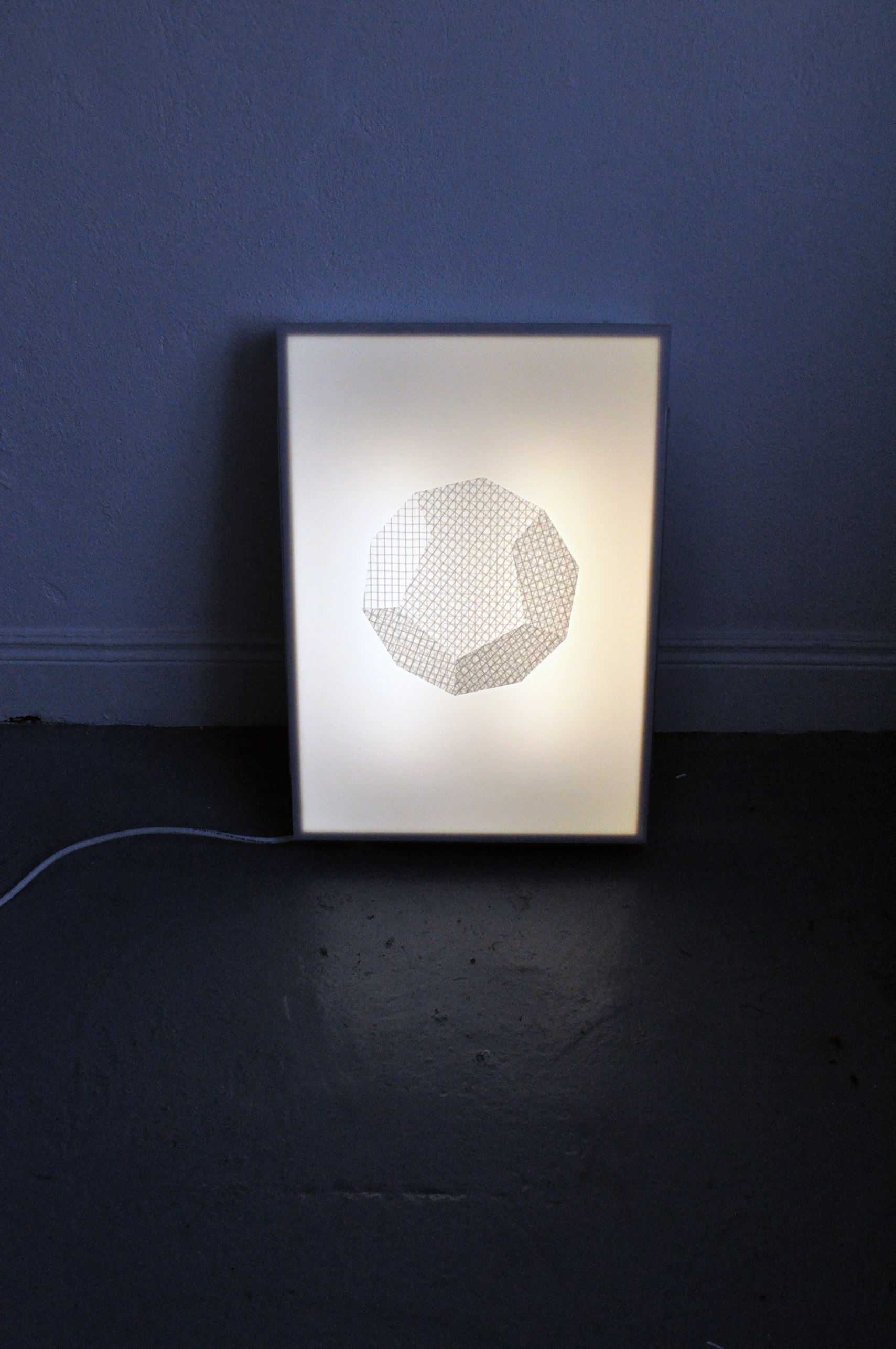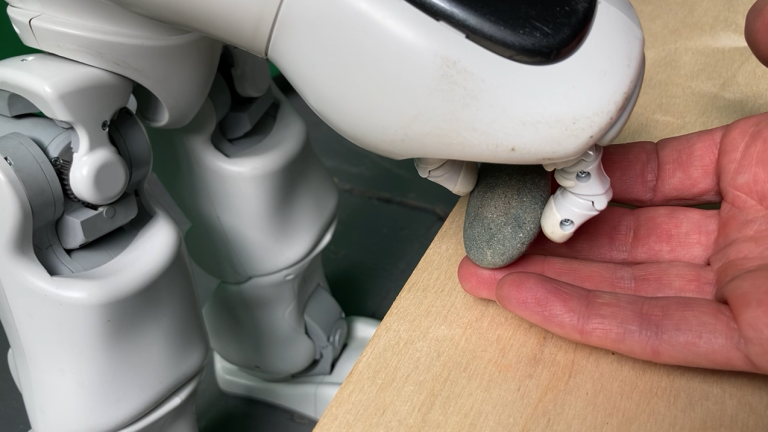A few of months ago I came across a short video of Northern Irish artist Keef (Keith) Winter performing on a street in Bahrain. In it he is drumming on a series of instruments – a plastic wheelie bin, a case, a cowbell, a pot, and the pavement stones themselves. Around him a horseshoe of locals provide backing music using small, lo-fi, rasping whistles / trumpets. Apart from the video being frenetic and very funny, there is something earnest about the effort with which Winter tries to summon a beat out of this series of standardised objects. They become a cityscape in and of themselves, with he, this mighty, drumming King Kong seeking some raw and rhythmic authenticity.
In Winter’s solo show at The Joinery – Hide those dirty hands – the everyman of his street performance becomes the handyman, the jack of all trades, etc.
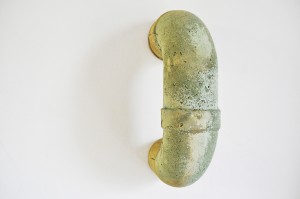
Keef Winter: Concrete U-bend, 2011
courtesy of artist.
The gallery walls of The Joinery are of masonry construction, painted white, and are clearly imperfect. In the back section of the front gallery sits an old, red, wood stove that was used for heating the water which was pumped through the building when it functioned, previously, as an actual joinery. Cut and capped pipes appear at different parts of the gallery space. The curators/founders Miranda Driscoll and Feargal Ward have left all of these features in plain view and Winter, in this show, acknowledges them.
In the front gallery there is a short section of white air duct, which has been passed through a clear perspex box. The duct appears to then run into the wall of the gallery, ‘venting’ the air away to an unknown destination. Across the room a minimalist looking light box has been placed on the ground, leaning against the wall, with an image of a dodecahedron [1] on it. The faces of the shape are indicated with small cut out sections of gridded clear tarpaulin. There is a build up of tone in the faces through the layering of this material. It is a crisp, attractive piece, with a sort of sci-fi aesthetic. I think/hope it is a reference to the Hamilton Puzzle. William R. Hamilton was an Irish mathematician who devised this puzzle in 1859.[2] At each point (vertex) of a dodecahedron he labelled a major international city. The challenge was to find a route along the edges of the dodecahedron which visited every city exactly once and returned to the start.
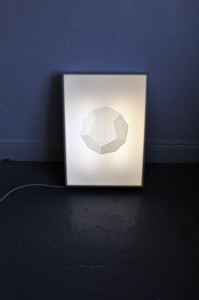
Keef Winter: Dodecahedron, 2011,
image courtesy of artist.
To the rear of the front gallery sit a set of ‘street lights’, a cast of a U-bend pipe fixed to the face of the gallery wall, and a wall mounted sculptural piece tucked away to the right corner. This sculpture comprises a white plane indented with a small facetted fractal shape, again, it is crisp, geometric and vague in its sterility. The street lights are made of gold-painted metal tubing. This tubing, fixed to small concrete bases, extends up to a T, where two standard house light bulbs emerge. These street lights are scaled down, brought within the human reach. One set of these lights work; the other is merely ornamental. It is in this too and fro between artwork and object-of-utility that Winter’s work here can be situated. The U-bend pipe is cast solid, in concrete, and further suggests the unglamourous and unseen machinations of a building. Here the viewer is buffeted between abstract sculpture, architectural re-appropriation, and the uncovering of utility services. Is the viewer on the street looking up at a building? Navigating around inside a building? Or in that space between the ceiling and the floor, amongst the beams and services within a building? Or all of these places at once?
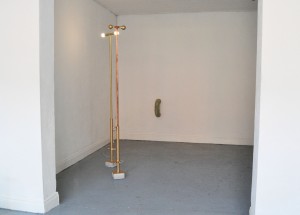
Keef Winter: Streetlights and Concrete U-bend, installation shot, 2011,
image courtesy of artist.
Winter’s way of talking about the urban built environment is singular. He manages to bring together the abstract and clean-lined aesthetic of the architectural with the plain sleazy – and somehow it makes sense. No more so than with his installation piece that sits in the darker back gallery of The Joinery. In this room the underside of the roof is exposed leaving the rafters and weathering material visible. Here Winter has built a sort of home-made portaloo, with sections of timber joists, black polyurethane sheets, and MDF. It is well constructed. At the back of it are a set of steps that lead up to a door which leads into the chamber. Within this physically constricting chamber we are presented with an urgently cut glory hole in the side wall (I spent many, many hours staring at this, alas, nothing). Underneath this construction sits another clear perspex box filled with a sinister black fluid, a sort of in-vitro waste-water cistern. At the foot of the steps there is a sheet of glass on its side, leaning against the wall of the gallery. It is badly cracked, and alongside it sits a small, black sculpture: two fused square based pyramids – a geometric object of dissent.
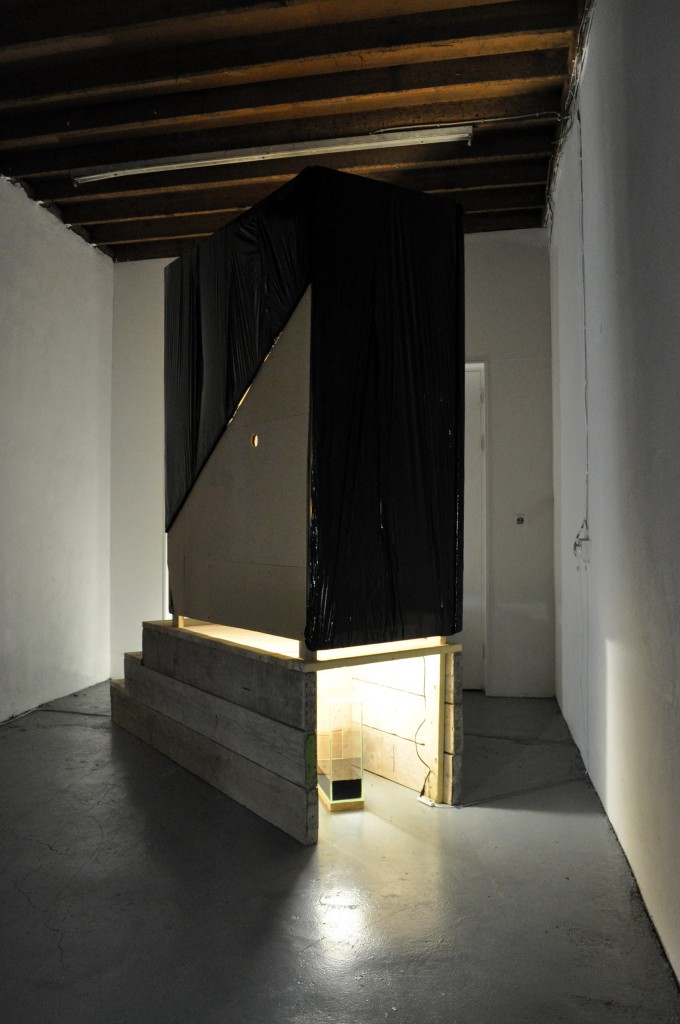
Keef Winter: Glory hole, installation shot,
image courtesy of artist.
This strange, murky installation brings the viewer into a position of active inhabitant. The cracked glass and geometric missile are a recognisable set of symbols designating unrest, and is perhaps an over-committed gesture. However, the black humour of the glory hole installation leavens this, and brings the work to a place somewhere between serious social comment and sexual fantasy. Despite the potentially disparate sets of aesthetic genres being employed, there is a visual coherence to this show – the ratios of the Paul Thek-like perspex boxes, the portaloo chamber, and the light box all seem compatible. There is an analysis of the aesthetic of necessity in these objects of installation and sculpture. Stasis and flow are evoked too. Winter proposes buildings and urban centres (and galleries) as places with both seen and unseen links – links that can be at once ideal, in a mathematical or geometric sense, but also as corporal, slow, and encumbered with an often forgotten filth.
Adrian Duncan lives in Dublin.
_______________________________
[1] Name of a solid, which is usually made up of twelve pentagon-shaped faces.
[2] He is most famous for his work in complex numbers, refer to the canal bridge parapet at Broombridge in nearby Dublin 9.

